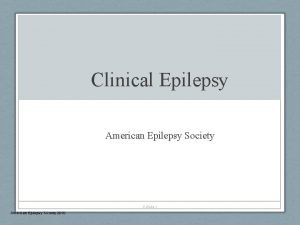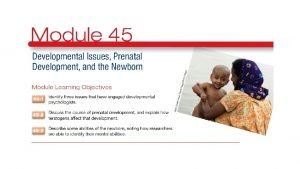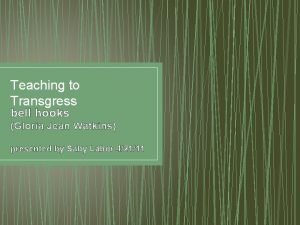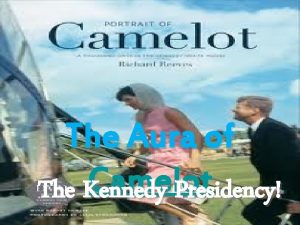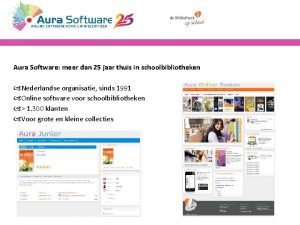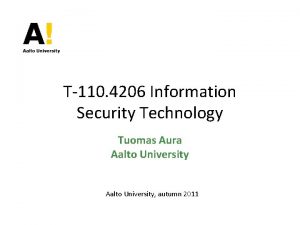aura Engaged Excellence in Research Teaching Practices Learner






















- Slides: 22

aura Engaged Excellence in Research & Teaching Practices Learner Preferences & Styles Teaching Course 1, Session 3, Day One,

Session Learning Objectives In this session, you will: 1. Discover different learning styles and preferences, and explore its significance on course design and delivery 2. Compare two learning metaphors, and consider the impact on your role as an educator 3. Judge the effectiveness of a learning design that adopts an iterative process as an ongoing experiment of refinement and improvement

Group Activity 1: Different Training Methods Review the trainer scenarios provided, and: 1. Identify examples of the different educational approaches 2. Share your insights about the usefulness/limitations of these methods with the group

Trainer Scenario: Educator A Trainer A prefers to provide their participants with a set of comprehensive facts and definitions in their workshops using presentations to support the learning of new ideas and theories. Typically, they stand at the front of the classroom and demonstrate how to use the information sources. They also offer guidance on how to resolve problems participants might encounter (for e. g. problems you might encounter when locating research in an e-database). The workshop participants usually take notes during their sessions. When they apply practical skills they use the guided learning materials supplied by Trainer A. Participants demonstrate their learning by individually completing written tests contained within the learning materials.

Trainer Scenario Continued: Educator A Trainer A prefers to provide their participants with a set of comprehensive facts and definitions in their workshops using presentations to support the learning of new ideas and theories. Typically, they stand at the front of the classroom and demonstrate how to use the information sources. They also offer guidance on how to resolve problems participants might encounter (for e. g. problems you might encounter when locating research in an e-database). The workshop participants usually take notes during their sessions. When they apply practical skills they use the guided learning materials supplied by Trainer A. Participants demonstrate their learning by individually completing written tests contained within the learning materials.

Trainer Scenario: Educator B Trainer B uses a mixture of definitions and problem-solving activities in their workshops. At the beginning of the session, they encourage the participants to share their prior experiences and knowledge in groups. Trainer B feels comfortable with participants putting forward their own ideas and strategies for locating information in a database (for example). Trainer B prefers not to use guided materials, instead he/she sets a problem and encourages participants to work independently, or in small groups, to solve the problem while they walk around the room offering support and assessing their ability / skills. At the end of the session, Trainer B asks participants to critically reflect on the learning experience and comment on how theory can be applied to their work.

Trainer Scenario Continued: Educator B Trainer B uses a mixture of definitions and problem-solving activities in their workshops. At the beginning of the session, they encourage the participants to share their prior experiences and knowledge in groups. Trainer B feels comfortable with participants putting forward their own ideas and strategies for locating information in a database (for example). Trainer B prefers not to use guided materials, instead he/she sets a problem and encourages participants to work independently, or in small groups, to solve the problem while they walk around the room offering support and assessing their ability / skills. At the end of the session, Trainer B asks participants to critically reflect on the learning experience and comment on how theory can be applied to their work.

Metaphorical Mapping, Sfard (1998) Acquisition Metaphor Individual enrichment Participation Metaphor Goal of learning Community building Acquisition of something Learning Becoming a participant Recipient (consumer), (re-)constructor Student Peripheral participant, apprentice Provider, facilitator, mediator Teacher Expert participant, preserver of practice / discourse Knowledge, concept Aspect of: practice, discourse, activity Property, possession, commodity (individual, public) Having, possessing Knowing Belonging, participating, communicating Sfard, Anna. "On Two Metaphors for Learning and the Dangers of Choosing Just One. " Educational Researcher 27, no. 2 (1998): 4 -13

Learning Style & Preferences Learning theory Learning style

Activity 2: Learning how to Drive a Car Reflect on your learning experience and write down: 1 x successful methods, tools, learning approaches 1 x less or unsuccessful methods, tools, learning approaches Disk Depot, Wikimedia

Learning how to Drive a Car: Continued Hearing / listening hearing & trying hearing & seeing hearing, seeing & trying Seeing/Reading seeing & trying Moving/Trying

Learning how to Drive a Car: Continued Hearing /Listening hearing & trying hearing & seeing hearing, seeing & trying Seeing/Reading seeing & trying Moving/Trying

Preference & Style Nationaal Archief, Flickr

Learning patterns US National Archives, Flickr

Structure verbeeldingskr 8, Flickr

Flexible verbeeldingskr 8, Flickr

Independent Shaun Mitchem, Wikimedia

Social Danilobu, Wikimedia

Hear, See, Move Six. Sigma, Wikimedia

Are we doing a disservice? Assessing learning styles Various Instrument available: • Personality Type Indicator Myers - Briggs • Learning Styles Inventory Dunn & Dunn • More exist. . Look online US National Archives, Flickr

Session Learning Outcomes You should now be able to: 1. Discover different learning styles and preferences, and explore its significance on course design and delivery 2. Compare two learning metaphors, and consider the impact on your role as an educator 3. Judge the effectiveness of a learning design that adopts an iterative process as an ongoing experiment of refinement and improvement

The content is authored by: Siobhan Duvigneau, AURA Programme Manager, Institute of Development Studies, S. Duvigneau@ids. ac. uk This work is licensed under a Creative Commons Attribution. Non-commercial Share. Alike 3. 0
 Migraine aura vs seizure aura
Migraine aura vs seizure aura Remarks on lazy and eager learning
Remarks on lazy and eager learning Tamu english language proficiency
Tamu english language proficiency Teaching excellence and achievement
Teaching excellence and achievement Abu dhabi award for research excellence (aare)
Abu dhabi award for research excellence (aare) Is jennifer coffey engaged
Is jennifer coffey engaged What three issues have engaged developmental psychologists?
What three issues have engaged developmental psychologists? Brooke powell engaged
Brooke powell engaged Bell hooks engaged pedagogy summary
Bell hooks engaged pedagogy summary Nathan goshen engaged
Nathan goshen engaged United healthcare simply engaged program
United healthcare simply engaged program Micro teaching is a scaled down encounter
Micro teaching is a scaled down encounter Aura vs prodrome
Aura vs prodrome Avaya aura architecture
Avaya aura architecture Camelot aura
Camelot aura Migraine avec aura définition
Migraine avec aura définition Aura soma farben
Aura soma farben Laura doro
Laura doro Aura phase serial killer
Aura phase serial killer курсы avaya aura
курсы avaya aura Aura 7
Aura 7 Software dbos
Software dbos Tuomas aura
Tuomas aura
